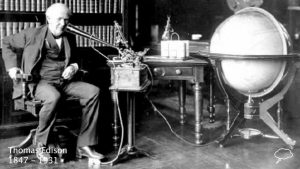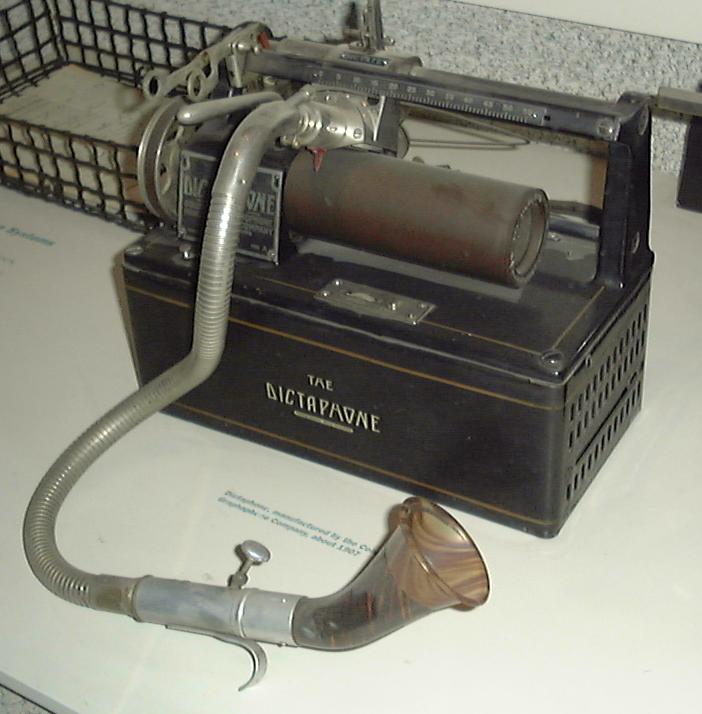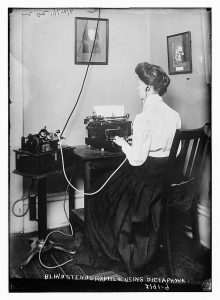History of Dictaphone

The history of Dictaphone goes back to the invention rivalry of Thomas Edison and Alexander Graham Bell.
Although it was Edison who was the first one to come up with a phonograph device using cylindrical tinfoil, Graham Bell thought of modifying it to improve portability and sound quality through cylinders made of wax instead of tin foils.
With his company called Volta Graphophone Company, the first Dictaphone was released. As such, Graham Bell is considered as the inventor of the Dictaphone.
What is a Dictaphone used for?

The Dictaphone provided convenience for transcribers and stenographers. As the name implies, the Dictaphone is a dictation machine which works like a tape recorder.
Through the introduction of the Dictaphone, letters, meetings, lectures and even the proceedings for seminars could be recorded so that the transcriptionists or executive secretaries of companies could write the minutes or information from the session while listening to the device or for playback later. Dictaphones include tape recorders and digital voice recorders.
Advantages of Dictaphone

In contrast with other recording devices of its time, the Dictaphone has three major advantages.
The first would be in terms of battery life. It has a maximum of 48 hours of battery life and you can even carry spare batteries with you if you ever need them on the field. Another advantage is the ease of use.
With single button presses of record, pause, stop, and play, you can just record and playback anytime. And of course, the sound quality is superb.
Modern day Dictaphones are of course already advanced in terms of sound quality because of HiFi technology. But even then, it was already beyond its years because of its concert-hall type of sound and accuracy of details.
What is a Dictaphone transcriber?
The name Dictaphone is a trademark of Graham Bell’s company at that time so the Dictaphone transcriber could refer to two things.
First, it may refer to the Dictaphone itself because at present day, it is called just transcriber.
Second, it may refer to an installed software in modern Dictaphones that is used for the device to transcribe audio to text with accuracy.
How much is a Dictaphone worth?
The Dictaphone was surely a turnaround in audio recording and transcribing which is why it should not come as a surprise if it sold for as high as $200 in 1910 when it was at the peak of its fame.
As of the moment, it does not fall far from the price range that we have mentioned. Functional Dictaphones at present are sold from $120-270 depending on what purpose it is used.
Medical Dictaphone transcribers are more expensive than the average audio to text transcribers used by office secretaries and documenters.
Vintage Dictaphones are also being sold in auctions and it is within the range of $85-150.
What is the difference between a voice recorder and a Dictaphone?
Contrary to popular belief, the Dictaphone is considered as a digital voice recorder. As a matter of fact, voice recorders are categorized into two types: the digital Dictaphone and the digital notetaker. Perhaps, it is then better for us to delineate a Dictaphone from a notetaker.
A digital notetaker is used for multi speaker audio such as seminars, lectures, focus group discussions and speeches in one take only or with a few interruptions. For you to get an accurate transcription of the event, the notetaker will require you to use a high-end microphone to pick-up the slightest sound.
On the other hand, the digital Dictaphone is typically used for a single speaker audio or with just one person dictating everything. It is useful for recording short speeches and lectures.
The Dictaphone has more functional buttons though. With it, you can rewind, review and playback the recorded audio for more accurate transcriptions.
Are Dictaphones still used?
Yes, they are still out and about up to this day. Journalists and medical transcribers are still on the forefront of the market that Dictaphone companies are supplying.
It is still considered as one of the most reliable devices for capturing accurate sounds and of course, high quality audio. As a matter of fact, you can find the best Dictaphones of 2019 all around the net, ranked by reputable blog sites.
Can I use my iPhone as a Dictaphone?
Honestly, not just iPhone but all smartphones could be used as Dictaphones now.
Smartphones have built-in recorders and like the Dictaphone, they are built with the highest, most updated specifications to be used as how one would use a Dictaphone.
Nonetheless, iPhones as Dictaphones could not be used in medical transcription because medical transcribers follow a standard. But for journalists, the voice recorders in phones have become a handy way to cover news and store recorded information. But with how busy journalists could get with phone calls here and there, a separate voice recorder is still a must.
FAQs
When was the first dictation machine invented?
The first working dictation machine was invented in 1877 by Thomas Edison, called the tinfoil phonograph. It recorded voices on phonograph cylinders wrapped in tinfoil.
Who invented the Dictaphone?
The Dictaphone was invented by Alexander Graham Bell’s Volta Laboratory and brought to the market in 1907 by the Columbia Phonograph Company. It recorded voices on wax cylinders.
What was the Ediphone?
The Ediphone was an office dictation machine introduced in 1923 by Thomas Edison. It used blue Amberol cylinders to record dictation.
When were dictation machines first used in offices?
Dictation machines started being used in offices in the early 1900s to record letters and memos more efficiently than writing by hand.
What was the first magnetic tape dictation machine?
The first magnetic tape dictation machine was the SoundScriber, introduced in the 1940s. It recorded dictation on a magnetic tape cartridge.
How did the microcassette change dictation machines?
Dictation machines moved from magnetic tapes to microcassettes in the 1970s, making them smaller and more convenient. Olympus launched the first microcassette recorder in 1969.
When did digital dictation machines emerge?
Digital dictation machines that could store audio files on memory chips emerged in the 1990s, starting with Philips’ Digital Pocket Memo.
What are modern dictation machine brands?
Major modern dictation machine brands include Philips, Olympus, Sony, Grundig, Sanyo and more niche brands like TASCAM and Zoom.
When did speech recognition enter dictation machines?
Speech recognition technology allowing automatic voice-to-text started entering business dictation machines in the early 2000s.
Are dictation machines still used today?
While recording on phones is more common, dedicated dictation machines continue to be used today by legal, healthcare, business, and transcription professionals.







